#kamakura festival
Explore tagged Tumblr posts
Video
tumblr
Miko (Shrine Maiden) Performance at Kamakura-miya Shrine Unohana Matsuri (Festival of the Rabbit) by 深澤敦
Miko (Shrine Maiden) performing a traditional dance to the music of gagaku, which was popular during the Heian Period when arts and culture flourish.
#miko#shrine maiden#kamakura#kamakura miya shrine#unohana matsuri#japanese festival#festival of the rabbit#japan#japanese culture#japanese tradition#heian period#gagaku#japanese music
77 notes
·
View notes
Photo

Kamakura Spring Festival
Early — Mid April
The Kamakura Matsuri is a week-long festival held from the 2nd Sunday of April to welcome in spring. The festival has been held since 1959 and today includes traditional theatrical performances, tea ceremonies, and — the most popular event — horseback archery (流鏑馬, yabusame). The archery event is held at Tsurugaoka Hachimangu Shrine from 1pm on the final Sunday with the first arrows let loose at 2pm.
#Japanese Culture#Kamakura Matsuri#Horseback Archery#流鏑馬#Yabusame#Kamakura Spring Festival#Japanese Archery#Kamakura#Spring#Matsuri#Kanagawa#Nippon#Spring Events
15 notes
·
View notes
Text
Shiftmas 2024

Day 4 - What does a hang out with you friend group look like? Where do you go? Who is your friend group?

; there's 4 people in my friend group not including me: Yui, Aoi, and Rii!
; Yui is my childhood best friend. She loves all things girly, and is super fashion obsessed. She loves Harajuku fashion and taking purikura!!! I love going out and taking Purikura together, as a friend group and even as a duo. going shopping as well!!!
; Aoi is a girl that was in my class last year (she is this year too, but that's how we met.) Everyone loves her, but she's a bit shy at first. She doesn't like talking to people she doesn't have to, but once you know her, she's so sweet and compassionate. I love her style! It's so tomboyish.
; Rii's real name is Rika, but nobody calls her that besides her parents. she's the most optimistic person you'll meet! she transferred this year from Guangzhou, China after a year abroad. She loves fish, jpop, and shoujo manga. I've never seen a bigger reader!!!!




; What a hang out is like, you ask? it's fun, loud, and sometimes a little chaotic at times. That's coming from a girl who used to hold the crown as the loudest girl alive in her class last year... But, that's what I love about them! you can tell them anything. they're so supportive, and funny. I'm never NOT smiling with them, my mouth hurts when I'm with them.
; Usually we take the bullet train to Tokyo or Shibuya. We live in kamakura, so, both are about an hour ½ away. We go to arcades, fashion shopping at liz lisa, axes femme, la pafait and other places. We go to bookstores, the beach, window shopping, to shrines, our houses, cute cafes, etc. Lots of places, and lots more we want to go to!!! during summer break, we're planning to take a trip to somewhere like Osaka. Or go to some fun summer festivals!!!

#shiftmas2024#shiftmas#reality shifting#shiftblr#permashifting#shifters#shifting community#shifting blog#shifting antis dni#shifting consciousness#shifting realities
21 notes
·
View notes
Text

The White Torii by the Sea: The Charm of Ubara Beach and Yasaka Shrine・海辺の白い鳥居: 鵜原ビーチと八坂神社の魅力
Location: Ubara Beach, Chiba Prefecture, Japan Timestamp: 10:43・2024/07/10
Pentax K-1 II + DFA 28-105mm F3.5-5.6 + CP + 10-stop ND filter ISO 100 for 3.0 sec. at ƒ/11
The iconic white torii gate of Yasaka Shrine on Ubara Beach, located about 100 km southeast of Tokyo, beautifully contrasts against the vibrant blue sky and turquoise waters of the cove, creating a serene and picturesque scene.
The shrine, founded during the Kamakura period, is a testament to the area's rich history and cultural significance. Ubara Beach is celebrated as one of Chiba Prefecture's most scenic spots and is a favorite destination for both relaxation and exploration.
Discover more about the history, festivals, and additional resources in my full write-up (1-minute read): https://www.pix4japan.com/blog/20240710-torii
#海景写真#千葉県#鵜原海岸#白い鳥居#pix4japan#pentax_dfa28105#pentaxk1mkii#seascapephotography#Japan#chibaprefecture#ubarabeach#whitetorii
18 notes
·
View notes
Text

Hideaki Anno's lantern at the Bonbori Festival in Kamakura
114 notes
·
View notes
Text
[Gakuen K] Extras Translation
Snowball fight in the Red club

LIST OF CHAPTERS
[Translation under the cut]

Kusanagi: Yata-chan, it's unusual for you to hum. Did something good happen?
Yata: Hehe. A bit.
Saya: I wonder what it is…Did you wake up refreshed in the morning?
Yata: I-I-It's not like that! I mean, don't talk to me all of a sudden!
Saya: It's been more than 6 months since I joined the Red club…I think it's time for you to get used to me already.
Yata: S-Shut up! What's impossible is impossible!
Kusanagi: Oka-ay, let me get back to the topic. You won the lottery…no way. You're not old enough to buy a ticket yet.
Kusanagi: What on earth is it? Don't waste our time, tell us.
Yata: Hehe…It's snowing today.
Saya: …So it's about the weather?
Yata: Of course. What else could it me (meet)-…be? (He mixed up the words ある "to be" and あう "to meet")
Saya: Ah, you stuttered.
Yata: No, I didn't!
Kusanagi: Yes, it is, it's unusually snowy. …So?
Yata: So, that's what I said. That's all.
Saya: That's all?
Kusanagi: What the heck is that? I lost hope.
Yata: W-What's with that reaction! Snow is exciting, isn't it!
Kusanagi: Uhhh…, well, maybe a little? Even if it's exciting to the ends of hair, but I don't think it's something to put on airs.
Yata: Snow is super awesome. First of all, you can play with it by throwing it!
Saya: U-Uhm. That's right…
Yata: And you can do it from the house!
Kusanagi: By "house" you mean Kamakura (snow hut)? I don't think I want to live there.
Yata: And to top it all off, it's also art! The snow festivals in the north are as good as they look on TV!
Yata: Snow is amazing!
Kusanagi: …Sorry, Yata-chan. I have never had that much respect for snow.
Totsuka: Fuuu, so cold, so cold…Hey, look outside. There's snow everywhere.
Saya: Totsuka-senpai.
Kusanagi: Even if you didn't say that, we know. I mean, we were just talking about it.
Totsuka: And what was the talk about?
Saya: Yata-kun was telling us that he is in a good mood because of the snow.
Totsuka: Haha, I see. Yata, you are like a dog.
Yata: …Like?
Totsuka: You know, there's a children's saying "Dogs run around the garden with joy". It seems to me that if you replace the dog with Yata, there would be no problem.
Totsuka: Still, it falls a lot this year.
Saya: Is that so?
Totsuka: Ahh, I see. It doesn't ring a bell since this is your first winter on the island.
Kusanagi: I don't know much about the weather, but I heard that cold waves don't reach this island very often. That's why kids are so happy when it snows.
Yata: I'm not a kid!
Totsuka: High school students are still kids. So, why don't we all have a snowball fight?
Yata: I agree!
Saya: Me too!
Kusanagi: I'll pass.
Totsuka: Eh, you aren't going to join us, Kusanagi-san?
Kusanagi: Sorry. I don't want to get out of the warm place.
Yata: I'll call Kamamoto. I'll make him participate even if he refuses, even if I have to drag him along!
Totsuka: It's okay if he refuses, there's no need to force him to participate--. He's gone.
Saya: It looks like Yata-kun is very happy to be able to play in the snow.
Totsuka: It seems like he is. King on the other hand…
Saya: He seems to be sleeping in the corner. Do you want me to wake him up?
Totsuka: Umm, no thanks. I can't imagine King getting excited about snow.
Totsuka: It would be hard for him to sleep in the snow if we wake him up and take him with us.
Totsuka: Well then, let's go outside and wait for Yata and the others.
Saya: Okay!

Kamamoto: So cold… Yata-san, let's go inside.
Yata: Go inside? We're playing now! What's that stupid fat of yours for?!
Kamamoto: At least it's not for snowball fights.
Totsuka: If you move your body, you'll get warmer. So, it's a team showdown: me and her against Yata and Kamamoto, is it okay?
Saya: Yeah!
Yata: No problem.
Kamamoto: L-let's hurry…
Totsuka: Okaay. Time limit is 5 minutes. The one whose clothes do not get wet wins.
Totsuka: Okay, let's start. Let's have--a fair fight!

Totsuka: Hide in the shadows there, hurry!
Saya: Okay!
Kamamoto: I won't let you do it…Whoa!
Totsuka: Now that was a decoy strategy. Thanks for falling for it, Kamamoto.
Yata: Tch…If things continue as they are, we will lose. We have to give it our all.
Yata: Eat this! Yatagarasu Snowball Special--.
Kusanagi: Here, look. There's snow on the ground.
Mikoto: Yeah, it's piled up pretty well.
Yata: Eh! No way, seriously!? Mikoto-san, please move out of the way!!!
Mikoto: Eh?
Totsuka: Whoa- straight to the face…
Saya: Yata-kun…
Kamamoto: He really screwed up…
Yata: M-Mi-Miko-ko-ko…
Mikoto: …Yata.
Yata: Y-Yes!
Mikoto: Ha. That's a nice pitch, isn't it?
Yata: S-Sorry!!

#k project#gakuen k#gakuen k wonderful school days#otome translation#suoh mikoto#kusanagi izumo#totsuka tatara#yata misaki#kamamoto rikio#i've been missing my red family so here's the extra#yes it's a winter chapter in summer#i need to at least mentally cool down from this heatwave#i hate winter to be honest but wouldn't mind it right now
12 notes
·
View notes
Text
Minamoto no Yoshitsune: Chapter 5
Chapter 4
♡———♡
Yoshino: Yoshitsune-sama…?
???: …
When I called out to him hesitantly, the man turned around and removed his mask…
Yoshitsune: How did you know?
He tilted his head in wonder.
(It really was Yoshitsune-sama!)
Yoshino: Wh-Why are you... here of all places...?
(I thought the next time we'd meet would be on the battlefield...)
I called out to him on impulse, but my body stiffened at the realization that I was alone with an enemy commander, and I took a step back.
Yoshitsune: Don't be so wary. I have no intention of causing a commotion here.
Yoshino: Is that so...?
(But I can't imagine him coming to enemy territory alone. He must have someone with him...)
As I looked around, Yoshitsune-sama spoke as if he had read my mind.
Yoshitsune: I came to Kamakura alone.
Yoshitsune: I didn't even tell Benkei and the others. I infiltrated under the cover of the festival's commotion.
Yoshino: Infiltrated...?
To my question, Yoshitsune-sama kept his distance and threw out words.
Yoshitsune: Well, you've discovered my true identity, haven't you?
Yoshitsune: It was a waste, even though I tried to appear with a mask I luckily had with me.
(He went through the trouble of wearing a mask to hide his identity from me. But...)
Yoshino: Why did you even have a mask in the first place? Was it perhaps for a disguise or something...?
Yoshitsune: No.
He looked down at the fox mask, looking a little disappointed.
Yoshitsune: I don't dislike the festival atmosphere. I thought I could enjoy it a little.
(Wh-What an unexpected reason!)
(Is Yoshitsune-sama... a bit of an airhead?)
Yoshitsune: ––Anyway,
Yoshitsune: I promise I won't harm Yoshino tonight.
Yoshitsune: In exchange, you must not make a fuss until I leave.
(So it's not reconnaissance either?)
Yoshitsune-sama's straightforward words didn't seem to contain any lies.
(I know it's dangerous to trust an enemy commander, but...)
(Yoshitsune-sama kept his promise to 'spare me' before.)
(And most of all, he saved me when I was about to be assaulted by bandits.)
Encouraged by this fact, I lowered my guard.
Yoshino: Um, it's a bit late to ask, but why did you save me?
Yoshitsune: That's...
Yoshitsune-sama opened his mouth slowly, his expression unchanged.
Yoshitsune: I have no right to judge you either.
Yoshitsune: It leaves a bad taste to ignore someone when you have the means to help.
(Ah––)
**cabin flashback**
Yoshitsune: Why did you help him, knowing he was your enemy?
Yoshino: What…?
Yoshitsune: Answer me.
Yoshino: Well…
Yoshino: …I’m a pharmacist.
Yoshino: Having the means to treat someone and yet ignoring an injured person right in front of you is akin to being a murderer.
**end of flashback**
Back then, Yoshitsune-sama dismissed me, but he also said... "Everyone has contradictions."
(If he hates Yoritomo-sama enough to borrow the power of ayakashi,)
(Then surely he should kill me, who cooperates with Yoritomo, by any means necessary.)
And yet, Yoshitsune-sama extended a helping hand to me in my time of need.
Yoshino: Th... thank you, Yoshitsune-sama.
Yoshitsune: I did it of my own accord.
His nonchalant dismissal of his actions felt somewhat dazzling.
––At the same time, I recalled the day I saw Yoshitsune-sama in battle.
(I was chilled when I saw him charge towards the enemy without fear of injury.)
He skillfully maneuvered his horse, advancing towards the enemy.
Many soldiers were repelled by the overwhelming difference in strength.
(And yet...)
No matter how skilled he is in tactics, no matter how dangerous his fighting style, Yoshitsune-sama always sticks to his principles in the end.
(I don't think Yoritomo-sama would fight so recklessly. But...)
**imperial palace flashback**
Yoritomo: I intend to guarantee your personal safety, at the very least, since I’m bringing a mere woman onto the battlefield.
Yoritomo: However, there’s no such thing as absolute safety, as you experienced in the previous battle.
Yoritomo: Even so, it is the shogunate’s decision to continue involving you in this matter.
Yoritomo: Therefore, if you choose to cooperate with us of your own volition, it would be only fair to guarantee you better treatment than before.
**end of flashback**
(The more I get to know Yoritomo-sama, the more I feel that he is a fair person, even if it's hard to understand.)
(... There are some similarities between Yoritomo-sama and Yoshitsune-sama after all.)
The fact that these two were enemies caused a sharp pain in my chest.
Yoshitsune: Yoshino? Is something wrong?
Yoshino: ...N-No, it's nothing.
I was startled to realize that I had unconsciously clenched my fingers.
Yoshitsune: I see. Then, I must be going.
(...!)
As Yoshitsune-sama turned to leave, I called out to him on impulse.
Yoshino: Wait!
Yoshitsune: What is it?
(Oh no, I just...)
I was confused, not knowing why I had called out to him.
But for some reason, I felt like I shouldn't just let him go like this.
My eyes suddenly fell on the package I was holding.
Yoshino: ...Do you dislike dango?
Yoshitsune: ...Dango?
Yoshino: I just bought it at a stall. Would you like to eat it as a thank you for helping me?
Yoshitsune: There's no need for thanks. I did it of my own accord.
Yoshino: That's not how it works. I'd feel bad if I didn't do anything...
Yoshino: Ah, perhaps you don't eat dango? Should I have bought something else?
(Was it rude to offer food from a stall in the first place...?)
Yoshitsune-sama furrowed his brow slightly, as if a little perplexed by my anxious rambling.
Yoshitsune: That's not the case, but...
Yoshino: Th... then, please.
Yoshitsune: Very well.
(Thank goodness...)
We sat side by side on the stone steps, and I quickly took out the dango.
Yoshino: Here you go.
Yoshitsune: Ah. Thank you.
Yoshitsune-sama received the dango and casually popped it into his mouth.
Yoshino: Wow... It's so chewy and delicious.
Yoshitsune: ...Indeed.
(I should buy some for Tamamo as a souvenir.)
(Ah, but he's a gourmet, so he might say, "Dango from a stall?")
Yoshitsune: ............
(Huh? ...He seems to be frozen.)
Yoshino: ...Lord Yoshitsune? Did you not like it?
Yoshitsune: The taste is fine.
Yoshitsune: ...But this dango is quite chewy and a bit of a struggle.
Yoshitsune: It's difficult to time the chewing.
(Eh?)
Yoshino: Does that mean you don't like chewy things?
Yoshitsune: It seems so. It makes me sleepy while eating.
(Yet another unexpected side of him...)
(The difference between his appearance and his demeanor on the battlefield is truly extreme!)
Yoshino: I'm sorry, I didn't know... I should have gotten something else.
Yoshitsune: It's alright.
Yoshitsune: Your gratitude has been conveyed sufficiently.
Yoshino: Yoshitsune-sama...
(He really is... a sincere person through and through.)
--CHOICES--
You're so kind
Thank you
I'll choose something different next time
--------------
Yoshino: You're kind.
Yoshitsune: I merely stated the obvious.
Yoshitsune: But if that's how you see it, then so be it.
Having finished the dango, Yoshitsune-sama mutters to himself.
Yoshitsune: ...What a pleasant breeze.
The leaves rustle in the night wind, creating a soothing sound.
As I listen to the sound of the leaves and look up at the night sky, I see a pale moon floating.
Yoshitsune: The moon is beautiful tonight.
Yoshitsune: The moon seen in Hiraizumi is no different in beauty from the moon seen in Kamakura.
(Speaking of which...)
Yoshitsune-sama's words remind me of our first encounter.
Yoshino: You said you came to Kamakura alone, didn't you, Yoshitsune-sama?
Yoshitsune: If Benkei-san knew, he would nag me endlessly.
(Benkei-san... is that the scary-looking guy?)
(He's surprisingly overprotective...)
Yoshino: Why did you come all the way to Kamakura?
Yoshitsune: Well...
Yoshitsune-sama's eyes seemed to darken in the night.
A brief silence filled the air as I held my breath, and then a low voice echoed in the wind.
Yoshitsune: I wanted to see the town I would eventually destroy one last time before the battle.
(The last time...?)
Yoshino: Have you been to Kamakura before?
Yoshitsune: I stayed here when I was under Yoritomo-sama.
Yoshitsune: I was quite fond of Kamakura, but...
Yoshitsune: Shortly after the war with the Heike, I was exiled by Yoritomo-sama.
Yoshino: That's terrible...
(To think that it was his own brother who exiled him...)
Yoshitsune: That's why I came here to burn this last image into my memory.
Yoshitsune: ...The town and its people. They haven't changed from my memories.
Various emotions cast fleeting shadows on his sculpted, white profile.
Only he could know what those feelings were.
(But... I feel like I've touched Yoshitsune-sama's heart a little.)
We both fell silent, lost in our own thoughts, when––
???: Hey, hey...
(A child's voice...?)
A small boy emerged from the trees.
Boy: ...Oh man, he's not here either.
Yoshino: What's wrong? Are you looking for someone?
Boy: Ah, there are people here!
The boy notices us and approaches.
Boy: Have you seen my little brother? He's wearing a blue kimono...
Yoshino: No, I haven't seen him.
Boy: I see...
Yoshitsune-sama suddenly speaks to the dejected boy.
Yoshitsune: Did you get separated?
The boy flinches at the quiet question, then nods timidly.
Boy: Yeah... We had a fight, and he ran off.
Yoshino: Oh dear, that's worrying.
(With so many people in town, it must be hard to find someone once you're separated...)
Boy: It was his fault to begin with. But maybe I got too angry...
Boy: ...I looked everywhere, but I couldn't find him.
The boy clenches his small hands and tears well up in his eyes.
Boy: He must hate me now...
(Ah... It's easy to feel insecure after a fight.)
Yoshino: It's alright––
As I start to speak--
Yoshitsune: There's no brother who can easily hate his older brother.
(Yoshitsune-sama...?)
Yoshitsune-sama's words made the boy blink.
Boy: Really...?
Yoshitsune: Yes.
Yoshitsune-sama gently placed his hand on the boy's head.
Yoshitsune: But it's better to get along from now on.
Yoshitsune: ––Because people can't always walk the same path forever.
(Ah...)
Yoshitsune-sama's profile, illuminated by the moonlight, floated whitely in the darkness.
(I've never seen anyone with such a sad face.)
Even though his expression shouldn't have changed...
My heart tightened at the emotions quietly swirling in his eyes.
(Why does he look like that?)
I was incredibly curious, but...
(...I need to think about this child right now.)
I met the boy's eyes and spoke to him gently.
Yoshino: If you'd like, I can help you look for him.
Boy: Really?
Yoshino: Of course!
Yoshitsune: Then I shall join the search as well.
Yoshino: Really!?
Boy: Th-Thank you, big brother, big sister!
(But...)
I whispered to Yoshitsune-sama.
Yoshino: Is it alright? What if someone sees your face?
Yoshitsune: No one would think I'd be attending a festival with women and children.
Yoshino: Ah, that's true...
Yoshitsune: Besides, if need be, I can carve a path for myself even if I become a fugitive.
(He's that confident in his abilities.)
Yoshino: ...I understand. If you say so.
Yoshitsune-sama nodded once and looked around.
Yoshitsune: We haven't seen your brother since we've been here. Let's go out into the town.
Yoshino: Yes, he might be wandering around, drawn by the festival sounds.
I held out my hand to the boy.
Yoshino: Let's hold hands so we don't get separated, okay?
Boy: Okay!
The boy smiled brightly and took my hand.
Then, he boldly reached out his other hand to Yoshitsune-sama.
Boy: Here, big brother!
Yoshitsune: .....
(Wow...)
Yoshino: Um, this person... well, he's not the type to do that sort of thing...
Yoshitsune: Is this alright?
(Eh?)
Yoshitsune-sama, who had taken the boy's hand, asked flatly.
Boy: Yeah! Let's go, let's go!
Yoshino: W-Wait...!
I was pulled along by the boy, who started walking excitedly.
(...This feels strange. How do we look to others?)
(We certainly don't look like a family.)
Perhaps because the festival music was getting closer, I felt strangely restless.
(I wonder what Yoshitsune-sama is thinking?)
I glanced at his white profile, but as usual, I couldn't read his expression.
-
The town was even more crowded than before.
Yoshitsune: He doesn't seem to be here... Let's try looking over there.
Yoshino: Yes.
(I hope we find him soon...)
Boy: ...Ah!
Yoshitsune: What is it?
.
.
.
.
.
Chapter 5 Premium Story
If you’d like to support my translations, feel free to buy me a coffee here! :)
#ikemen series#cybird#ikemen genjiden#ikemen genjiden translations#ikegen yoshitsune translations#minamoto no yoshitsune translations#yoshitsune chapter 5 translation
13 notes
·
View notes
Text
What to do in Kamakura: the sightseeing guide or something…


The Kamakura Station, real and the manga versions
It is said to be less than an hour from Tokyo by train and one of the ancient cities in Japan along with Kyoto. Because of the countless shrines and temples, it is called the Kyoto of the East.
So where do you think the gang is going for a sightseeing ?
1) The Great Buddha of Kamakura. The Amida Buddha, which “referred to in Sanskrit as Amitabha Tathagata—the Buddha of Limitless Light, sits upon a lotus pedestal with his hands forming the mudra of meditation,” stands 11.4 meters on the grounds of Kotokuin Temple.
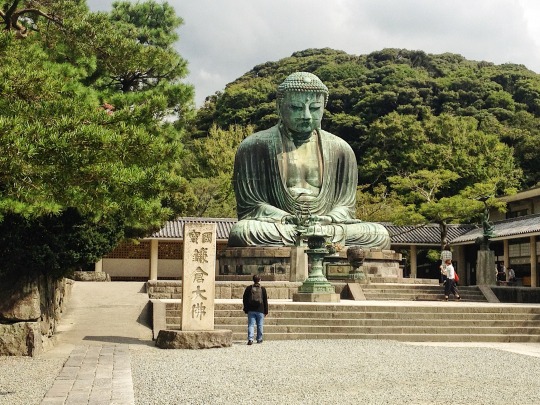
2) Hase Temple. It is said to the temple of the Jodo sect, one of two old sects that brought Buddhism to Japan, and in there resides the “famous eleven-headed statue of Kannon, the goddess of mercy.”
3) Enoshima is an island that has shrines, an aquarium, caves, an observatory tower and a beach that is very popular during summer where surfers like to go.
Searching for possible Lunar New Year festivities in Kamakura city owing to the many Shinto shrines and Buddhist temples located there, I encountered this passive aggressive information on this unofficial website.
Hari kuyo {hah-re-koo-yoh} at Egara Tenjin, 8th February
Hari is literally a needle, and Hari Kuyo is a memorial service in honor of used needles just like the Fude Kuyo (calligraphy brush memorial service). Nowadays, young women do not use needles, nor do they know how to sew. Until a couple of decades ago, however, needles had been one of the most important tools women had to use. Sewing is a technique required of women to master before marriage. The memorial service for needles was thus started years ago and it is still honored in various shrines.
I’ve heard of the funeral rite and a Buddhist temple for discarded dolls in Kyoto, but broken needles? Fascinating. This is in keeping with their animist tradition.
Source
#kamonohashi ron no kindan suiri#kamakura#ron kamonohashi#totomaru isshiki#akira amano#chapter 120#chikori monki
16 notes
·
View notes
Text
Temptation Towards Apoptosis - Track 03
L4mps 1st Feature Event

This chapter is translated by Jelly!
CW: Vomiting and Trouble with Food
This chapter includes vomiting and Toi struggling with food. If you do not wish to read that part of the chapter please skip from "We bought some garlic again~..." till "Nothing, the chief thought..." to avoid such content. However, if you wish to read, please read with caution.
Location: Lake Towada - Winter Story Festival
Chief: We’ve finally made it to the Lake Towada Winter Story Festival!

Toi: Waah…! The Christmas lights are so magical…!
Chief: I think the atmosphere here would still be nice even if it snowed…

Nagi: J-J-Just like the chief said yesterday, I-I-I’m glad it didn’t snow.
Netaro: Gii is passionately shivering.
Nagi: I-It’s because I-I-I-I’m cold.
Netaro: It seems inconvenient for warm-blooded creatures to be bad with the cold.

Ryui: Toi, let me know if you’re cold.
Toi: I’m alright. As long as I’m with you, Ani-sama.
Toi: (…I want to tell Nagi-kun that sticking to Ani-sama will warm him up too…)

Toi: (But I don't really want Ani-sama to hug anyone else except me…)
Chief: In addition to the festival, there are other activities to do nearby the venue as well such as going on the Oirase Gorge Frozen Night Bus Tour, or the Towadako Guidehouse KAI.

Nagi: B-B-Buchi-san, you said you visited the s-s-sauna this afternoon, right?
Daniel: Yeah, a winter sauna right smack dab in the middle of Lake Towada’s natural goodness. Really hit the spot.
Yodaka: I believe you said the temperature of the cooling pool was 2°C.
Nagi: *chatterchatterchatterchatter*
Ryui: Oi, Hachinoya froze up just imagining it.
Chief: O-Oh no…! There should be stalls by Yukiakari Yokocho, so let's warm ourselves up with the food there…!
Daniel: ‘Right, then should we split up? Me and Yodaka planned on going around together.
Chief: Ah, are you two going drinking again?
Daniel: Haha, ‘course we are. Is there anything better to do? Nope.

Netaro: Ahhhh, the unclouded flies of an alcoholic*!
Ryui: Eyes.
Yodaka: Actually, we were interested in visiting the Kamakura bars.
Chief: (Mmmm, this free-spiritedness is reminding me of our Hakodate trip…)
Ryui: Then should we go too? Warm up a bit before heading to the food stalls.
Toi: Wouldn’t that make us colder…?
Netaro: Nyope. The inside of a snow hut is actually warmer than the outside since the walls of snow trap the incoming air and make the hut insulated.
Yodaka: In that case, shall we be off? Danny, can you help carry Nagi?

Daniel: Ahh fine. Up you go.
*Daniel picks Nagi up*
Nagi: *chatterchatter*…
Chief: Netaro-kun and I will go get food for everyone first. I think they sell hot pork soup, grilled squid…

Netaro: Grilled squid! Grilled squid~ Pf-PFFT! Hehehe.
Ryui: The hell you laughing at?
Location: Aomori - Kamakura Bar

Nagi: …Phew. I’m saved.
Toi: Wow. It really is warmer inside.
Daniel: *whistles* The glass is all made outta ice. How bougie.
Yodaka: What should we order?
Ryui: I’ll take a soda. Or else I won’t be able to go around asking about Morozumi-san.
Daniel: Then we won't hold back on the drinks, so we're countin' on ya to drive us back, thanks Ryui.

Ryui: How the fuck did you know I got my license?
Daniel: Well I mean, you told the company, yeah? Anyways, we’re counting on ya.
Nagi: Um, Buchi-san. Even if a car comes equipped with autonomous driving, it’s still too much to make a beginner drive on an icy road at night. I can drive instead.
Daniel: No, your driving ain’t any better.
Yodaka: Ryui may just be a beginner at driving. However, sometimes it's best to learn from experience. Everything should be alright as long as someone is guiding him from the passenger seat.
Daniel: Yeah, you said it man. It’s like how they usually throw learners on the highway without warning.
Nagi: Hmm… I guess so. Like how people usually practice parking after they get their licenses. Then again the company van is pretty big. Parking it requires skill.

Toi: (…Oh, I didn’t know that.)
Nagi: Ryui, did you have any problems with the written test?
Ryui: My only problem was that the stuff they asked was a pain in the ass.
Ryui: Like, “You have to be careful when driving at night,” true or false… stuff like that.
Toi: (Isn’t the answer… true?)
Yodaka: In this case, the answer should be false. “Regardless of the time of day, one should always be careful when driving.”
Daniel: Ah yeah. There were a lot of trick questions mixed in.
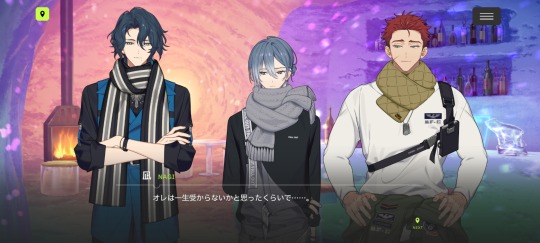
Nagi: I thought I’d never pass…
Snow Hut Visitor A: Oh, did you boys come here by car?
Snow Hut Visitor B: In that case, do we have the perfect snow tire recommendation for you!
Toi: …

Toi: (They’re talking about things I don’t understand…)
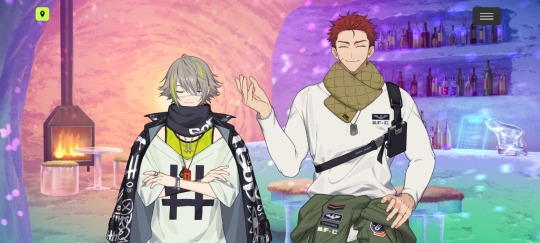
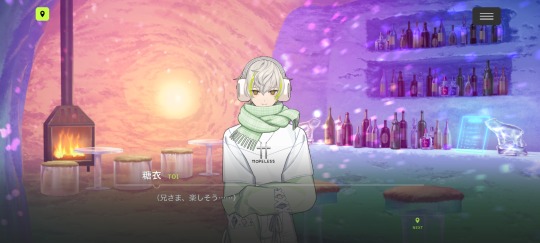
Toi: (Ani-sama… looks like he’s having fun…)

Yodaka: …
Yodaka: My boy. I think the chief and Netaro should be back with the food by now.
Toi: Oh… Then, I’ll go see if they’re here.
Yodaka: Let’s go together.
Toi: It’s okay, I can go by myself!
*Toi leaves*

Ryui: Oi… where’s Toi? Natsume, don’t tell me you chased him out?
Yodaka: Apologies. I thought I'd help him get a change of pace, so he went outside.
Nagi: Oh, is Toi the only one without his license…? Oops, he might have felt left out.
Daniel: He doesn’t plan on getting it?
Ryui: It’s not like he needs one. I already got mine.
Ryui: Though if he wants to get it, I don’t plan on stoppin’ him either. But for now, I wanna be the one to drive.
Nagi: Why?

Ryui: Just think about it, imagine Toi riding in my car at night. He’d probably say somethin’ like, “I need to stay awake since Ani-sama is driving…” while dozing off. Isn’t that so admirable of him?
Nagi: I. Recommend chewing some gum. Then.
Ryui: And then while waiting for the light, I can relish in the moment of Toi sleeping in the passenger seat… and that's all I thought about so far.
Daniel: Your mind surely does work wonders.
Yodaka: Though it seems probable in the near future.
Location: Lake Towada - Winter Story Festival
Chief: Oh, Toi-kuuun!

Toi: Chief, Netaro-san. How were the food stalls?
Chief: It was super busy! And there was even a stage for live performances.
[CW: Toi's struggle with food starts here]
Netaro: We bought some garlic again~ Unlike Ryui, I am not a dingy stingy, so Toi can have some too. Here!

Toi: (…I don’t really want it, but Netaro-san went out of his way to share with me…)
Toi: Then, I will take a piece…
Toi: …, …
Toi: (Urh… It smells and my chest hurts… I don’t think I can, do this after all…)
Netaro: You aren’t gonna eat it~?

Toi: Huh, oh, no, I will. In that case… thank you.
Toi: …ng, …

Toi: (I feel, sick…)
Chief: We should head inside now, but I wonder if it will be too packed?
Netaro: It’ll be fine~ Since the dawn of time, JPN salarymen have always been a species well known for their exceptional ability to squeeze into small spaces!
Toi: (Since I put it in my mouth already, I have to do my best to swallow…)
Chief: Toi-kun, how does it look inside—

Toi: O-Oh… It was... pretty busy in there…
Chief: Hm? Toi-kun, are you okay? You look pale…
Toi: A-Ahaha, do I…?
Netaro: Then do you want more garlic~? It’ll give you more nutrients to recover energy—
Toi: …!
Toi: S-Sorry… I need to use the bathroom…
Location: Snowy Path

Toi: Br… *pants*, *pants*…
Toi: (Urh… I can’t suppress this nauseating feeling…)

Toi: (And… I can feel something watching me again.)
Toi: Who’s—
Toi: Urh…!
Toi: Ble, blhehg… ue…, …!
Toi: Uuueeu… *pants*, *pants*… *panting*…!
Toi: (It’s out… But I’m feeling better—)

Ryui: TOI!!
Toi: !!
Toi: (Ani-sama’s coming…! Oh no, what do I do…)
Toi: Oh…! I can cover it up with the snow…!
Toi: (Sorry, I’ll make sure to clean it up later…!)

Toi: (What about my clothes...? Phew, it didn't get on them... The inside of my mouth feels disgusting, but I have to ignore it.)
Ryui: Toi!
Toi: Ani-sama, what’s wrong?
[CW: Toi's struggle with food ends here]

Ryui: Nothing, the chief thought you were taking your time so…
Toi: Sorry. I wanted to play in the snow for a bit—
*rustling*
Toi: Huh. What was that just now…?
Stoat: …
Ryui: A white animal… is that a stoat?
Toi: Waah, its fur looks like snow. It’s so cute…!
Ryui: But you’re obviously cuter.
Toi: Ehehe.
Ryui: It’s almost time for the fireworks to start, we should head back.
Toi: Okaaay.

Toi: I hope we can meet again… little Stoat.
Stoat: …
Notes:
Oirase Gorge is one of the most beautiful river valleys in Japan that is best known for their autumn foliage. In the winter, the waterfall freezes over creating frozen falls that is a must see for tourists to Aomori. For more info on the tour click here. For more info on the gorge click here.
Towadako Guidehouse KAI is a canoe experience to enjoy the beautiful nature of Lake Towada and Oirase Gorge. For more info click here.
Yukiakari Yokocho is a a shopping street within the festival where one can enjoy the local specialties of Aomori.
When Netaro says "unclouded flies," he gets the saying wrong. It's supposed to be unclouded eyes, but in the original he says the unclouded sea cucumber. It was hard to fit this in for the pun, so sea cucumber was replaced with flies. Sea cucumbers also happen to be an important element in Aomori's new year cuisines and the most valuable type of sea cucumber here is called the Yokohama sea cucumber. More info click here
Kamakura Bars are Snow hut bars in the festival space that is known for its excellent sake.
Stoat is a weasel looking animal native to Eurasia, also known as ermine.
Event Masterpost
Next Track
#18trip#18tlip#18trip translation#hachinoya nagi#nagi hachinoya#toi shiramitsu#ryui shiramitsu#netaro yowa#l4mps#hiroshi daniel iwabuchi#yodaka natsume#momiji hamasaki#kaede hamasaki#l4mps feature event#temptation towards apoptosis
5 notes
·
View notes
Text
5 Years Later Story Event Highlights (Yoichi and Shigehira)
Yoichi and Shigehira are friends again. They come to see each other frequently and sometimes Yoichi surprises Shigehira out of nowhere by walking into his house. They are all buddy-buddy now!
Yoichi still calls Shigehira 'Botchan' meaning Young master teasingly and Shigehira gets back at him by calling him baby-faced and then they start to fight like kids.
Yoshino also joins them and congratulates both of them for their achievements. Shigehira was able to revive the Taira Clan and both Nasu Clan and Taira Clan are in good terms now.
They both ask what Yoshino's biggest dream is and Yoshino simply says that she just wants to spread happiness and everyone to remember their happy memories once in a while. She tells them that maybe hosting something like a small festival will bring everyone together once in a while.
Listening to her wish, both Yoichi and Shigehira decided to make Yoshino's wish come true. They both lovingly hold Yoshino's hands and promised her.
A month or so later, Yoshino wish does come true. In Kamakura, preparation for a small festival started, to celebrate everyone's happiness. All the male leads joined and decided to contribute in their on way.
While Shigehira and Yoichi were walking around the town of Kamakura where the festival was taking place along with Yoshino, they see Kagetoki and Benkei, who opened a sweet shop together. Benkei makes delicious sweets and Kagetoki drowns them with his syrup. Morinaga opened a store for people who are interested in flexing their muscles. He also invited Shigehira, Yoichi and Yoshino to watch naked brawny men dancing. Both Shigehira and Yoichi rejected his invitation and although Yoshino wanted to watch naked dancing men, she decided to reject Morinaga's invitation as well. Yasuchika and Tamamo opened some kind of divination stall or something.
After walking around town, the three of them sat on top of a small hill to relax while looking at the city. Both Yoichi and Shigehira then started taking turns to feed Yoshino sweets and Yoshino being embarrassed, still opens her mouth. After that, both the man cuddle with her as Yoshino's face was stuffed with sweets.
After a minute of relaxing, Yoshino thanked both of them for making everyone happy. Hosting a festival was not an easy thing, but due to Shigehira and Yoichi's personality, they were able to make people come together to enjoy a festival like this. Then both Yoichi and Shigehira tells her that their only goal is to make one particular woman smile. They don't care about anyone else.
Hearing that statement, Yoshino turns completely red from head to toe and started shaking nervously. She looks down frowning lightly and begs the both men to not make fun of her like that. Both Yoichi and Shigehira chuckles seeing her reaction.
Later they go back to the city to attend the festival and they were confronted by some shady men. Yoichi and Shigehira easily beats up the men in a matter of seconds and now they have to report this incident to both Yoritomo and Yoshitsune.
Yoichi Ending: Shigehira tells Yoichi to go enjoy the festival with his girlfriend Yoshino, while he does the 'cleaning up'. Yoichi didn't want to leave SHigehira alone but Shigehira assures him that this is his way of repaying Yoichi. When they were kids, both Yoichi and Shigehira once snuck out of their houses at night to go to a festival. They only had money to buy one snack and Yoichi bought Shigehira's favorite snack while acting like older brother for Shigehira. Now Shigehira wants to repay Yoichi for all that affection. Yoichi couldn't say anything back and smiles. Like a genuine smile and thanks him. Both Yoichi and Yoshino walk around the festival and suddenly comes across a store which was selling ice sculptures. They both look up to see Tamamo and Rikka. Tamamo dragged Rikka out of his comfy room to participate in the festival and Rikka despite looking reluctant, was ready to do anything for Tamamo. Tamamo compliments about Rikka's beautiful ice sculptures and encourages them to buy one. Yoichi lets Yoshino choose. Yoshino looked at each ice sculptures displayed and she saw an ice sculpture of two little boys. To her, it looked like young Yoichi an Shigehira. Yoichi smiles and decides buy that as a gift for Shigehira. Yoichi asks if Rikka can add a bow and a sword to make it actually look like them and Rikka looked reluctant because he's lazy. Yoichi says that he will pay more and Rikka asked if he could have Yoshino as his pay. Yoichi says no but he instead will give Rikka a list of places where he can sleep comfortably and no one can find him. Rikka happily accepts that offer and tells him that he will deliver the sculpture tomorrow because even though Rikka's ice magic is powerful and lasts longer than normal ice, he wanted to cast some kind of spells to make the ice sculpture last longer or something....I don't get this part. Anyways, after that both Yoichi and Yoshino started walking slowly towards their home. Suddenly, Yasuchika's fireworks show started and they stopped to watch. The fireworks show was so beautiful that both of them started feeling something and they both starts passionately making out. Yoichi wanted to do more, but Yoshino stopped him feeling all embarrassed and says they shouldn't do that in public. So they both run back home.
Shigehira ending: Yoichi tells Shigehira to go to the festival with Yoshino, his girlfriend. First they go to the shop that has the ring-throwing game. Throw rings and win prizes. While Yoshino was missing all her targets, Shigehira easily wins all the prizes. Two kids were watching them, and their eyes sparkle watching Shigehira. The little kids recognized him as Taira no Shigehira and they praised him for being so cool. Shigehira was taken aback at first but then smiled happily. Yoshino knew that the meaning behind that smile is that the Taira Clan has officially been revived and Shigehira's dream has come true. After that they run into Yasuchika, and he tells them that he's about to do a firework show. He tells them how it works and also told them that if they have any message they would like to convey to someone special, he can show it in the sky as fireworks. Like skywriting fireworks? Shigehira thinks for a second and then tells Yasuchika that he wants to convey a message to Yoichi. Shigehira wants the fireworks to be shown as 'Thank you' in the sky as way to thank Yoichi for everything he has done for him. Shigehira also wanted to get back at Yoichi for all the teasing, so doing this in public will surely embarrass Yoichi at least a little bit. After that, both Yoshino and SHigehira stands on a bridge where they can get a perfect view of the fireworks. The fireworks show starts and both of them where mesmerized on how beautiful it is. Then they hear Yasuchika's announcement: "Next, Shige-ch....Taira no Shigehira, has a special message for Nasu no Yoichi." The fireworks shots up into the sky and the words 'Thank you' was written on the sky. SHigehira smiled triumphantly thinking how embarrassed Yoichi would be after seeing this but also happy at the same time. But guess what? UNO reverse card Shigehira because Yoichi already made plans with Yasuchika BEFORE Shigehira did. Yasuchika's next announcement: "Next...Shigehira has a special message for Yoshino." Yoshino looks at Shigehira feeling surprised and even Shigehira looked surprised as if he didn't plan this. The fireworks shots up into the sky and the words 'I love you' was written in the sky. Both Yoshino and Shigehira starts blushing from head to toe, completely red and Shigehira pouted saying how he must try harder to get back at Yoichi next time. He realised that the message was actually from Yoichi to tease Shigehira and Yoshino. Both Shigehira and Yoshino can imagine Yoichi's charming smile in their heads right now. Shigehira was super disturbed and he picks up Yoshino and runs back to their home to make love to her.
#ikemen series#ikemen genjiden#cybird ikemen#cybird otome#otome#cybird#ikegen#ikemen mc#ikemen genjiden shigehira#ikemen genjiden yoichi
12 notes
·
View notes
Text

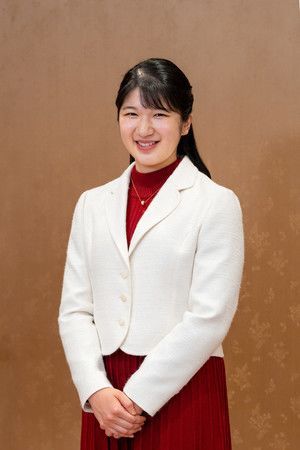

Japanese Princess Aiko, the only child of Emperor Naruhito and Empress Masako, turned 22 on Friday, as she is leading a busy and fulfilling university life.
The princess is currently in her final year at the Faculty of Letters at Gakushuin University in Tokyo. After pandemic-related restrictions were lifted in the country, in-person classes resumed for many courses at her university.
She started to attend classes on campus this spring. Based on literature from Japan's Heian, Kamakura, Edo and Meiji periods, she is working on her graduation thesis. Meanwhile, the princess enjoyed the university's school festival in November, according to the Imperial Household Agency.
In addition to Japan's traditional culture, the princess is interested in welfare activities. In October, she and her parents visited the headquarters of the Japanese Red Cross Society to see a special exhibition on relief activities following the 1923 Great Kanto Earthquake.
She also looked around the permanent exhibition there and seemed to be impressed by the involvement of Empress Dowager Shoken, the wife of Emperor Meiji, in the early years of the organization's activities.
Source
#princess aiko#emperor naruhito#empress masako#japanese imperial family#imperial family of japan#japan#japanese monarchy
21 notes
·
View notes
Photo


Yokote Kamakura Snow Festival
February 15th — February 16th
The ritual of hollowing out a mound of snow and building a small hut like an igloo is called “kamakura” (かまくら) in the snowy regions of northern Japan. Each year, more than 100 kamakura and many miniature versions are made around Yokote City in Akita Prefecture for the Yokote Kamakura Snow Festival (横手の雪まつり, Yokote no Yuki Matsuri). Candles are placed inside these igloo-like structures and visitors are invited inside to drink sake and eat rice cakes.
#Japan#Snow Festival#Yokote#Akita Prefecture#Yokote Kamakura Snow Festival#Kamakura#かまくら#Yokote no Yuki Matsuri#横手の雪まつり#Festival#Matsuri#Winter#Night#Nippon#Winter Events#Kamakura Snow Festival#Snow Huts
19 notes
·
View notes
Text


The keeper of the flames, Yokote Kamakura Festival
National Geographic, Sep 1994
2 notes
·
View notes
Text
Welcome the New Year in the Captivating City of Tokyo, Japan
Welcome the New Year in the Captivating City of Tokyo, Japan

Why Tokyo is an Unforgettable New Year’s Destination Tokyo blends centuries-old traditions with modern celebrations to create a truly unique New Year’s experience. Known as “Shōgatsu” in Japan, New Year’s is a time for reflection, family, and festivities. While Tokyo doesn’t have the typical fireworks displays, it offers mesmerizing temple bells, traditional ceremonies, and vibrant countdown events in iconic locations.
Top Experiences for New Year’s Eve in Tokyo
Temple Bell Ringing: Visit famous temples like Zojoji or Sensoji to hear the solemn toll of bells at midnight. This Buddhist tradition, called Joya no Kane, symbolizes purification and new beginnings.
Shibuya Scramble Countdown: Experience the energy of Tokyo’s youth at the Shibuya Crossing, where crowds gather for a lively New Year’s countdown.
Theme Park Celebrations: Join the all-night festivities at Tokyo Disneyland or DisneySea, complete with parades and magical lights.
Traditional Dining: Indulge in Toshikoshi Soba (buckwheat noodles), believed to bring longevity and prosperity in the coming year.
Explore Tokyo’s Wonders Beyond New Year’s Take advantage of your trip by discovering the unique charm of Japan’s capital:
Marvel at the cityscape from Tokyo Skytree or Tokyo Tower.
Wander through the tranquil Meiji Shrine and make your first prayer of the year.
Shop in Harajuku or Akihabara for quirky souvenirs.
Take a day trip to Mount Fuji or the historic city of Kamakura.
Insider Tips for Celebrating New Year’s in Tokyo
Many temples and shrines get crowded, so plan your visit early or opt for less-visited spots.
Public transport operates extended hours, but expect it to be packed on New Year’s Eve.
Some restaurants and shops may close for the holidays, so make reservations in advance.

Call to Action: Start Your New Year in Tokyo! Experience the magic of Tokyo this New Year’s with our expertly crafted travel packages. From flights and accommodations to tailored tours, we’ll ensure your trip is seamless and extraordinary. Book your Tokyo adventure now with Tokyo and welcome the year with a touch of Japanese tradition.
https://trip.tp.st/YE1nEDll
#tokyo#tokyo revengers#tokyo ghoul#tokyo mew mew#osaka#tokyo debunker#kyoto#street#shinjuku#street photography
5 notes
·
View notes
Text


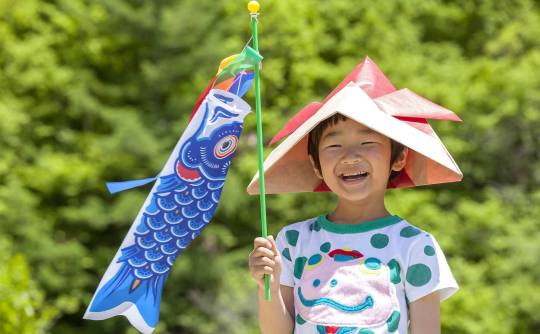

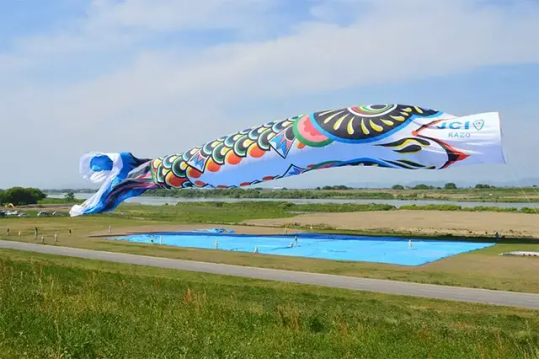
Sean bienvenidos japonsistasarqueológicos, a una nueva entrega cultural en esta ocasión os voy comentar la festividad, del día del niño que se celebra cada 5 de Mayo que se llama Kodomo no Hi y se escribiríaこどもの日 una vez dicho esto pónganse cómodos que empezamos. - ¿Cuándo surgió el día del niño?La festividad, surge en el siglo VIII d.c en lo que respondería al periodo Heian, posiblemente tendría influencia de china al respecto ya que se basó en Tango no Sekku. El Sekku se basa en los puntos de inflexión de las estaciones y se basa en la teoría de los cinco elementos del yin y el yang en China. - La forma tradicional de celebrarlo es ofrecer ofrendas estacionales a los dioses, rezar y comer juntos los productos de segunda mano.En el período Kamakura, en pleno auge de los samurais, se convirtió en un evento importante para orar por el crecimiento y la salud de los niños y la prosperidad de la familia, con adornos como armaduras, cascos, serpentinas de carpa y muñecos festivos. - Ahora a continuación mencionaré algunos dulces de los que se suelen comer el 5 de Mayo: Kashiwa mochi,Chimaki, beko mochi, akumaki , pastel no koi. - Espero que os haya gustado y nos vemos en próximas publicaciones y que pasen un feliz día del niño.
-
今回は、毎年5月5日に行われる「こどもの日」というお祭りについてお話しします。「こどもの日」とは、「こどもの日」と書いて「こどもの日」と読みます。 - こどもの日」の起源は、紀元8世紀の平安時代にさかのぼりますが、「端午の節句」が元になっていることから、中国の影響を受けている可能性があります。節句とは、季節の変わり目を表すもので、中国の陰陽五行説に基づくものです。 - 季節のお供え物を神に捧げ、祈り、中古品をみんなで食べるのが伝統的な祝い方です。 武士ブーム真っ只中の鎌倉時代には、甲冑や兜、こいのぼり、祝い人形などを飾り、子供の成長や健康、家族の繁栄を祈る大切な行事となりました。 - 柏餅、ちまき、べこ餅、あくまき、こいのぼりのお菓子です。 - 気に入っていただけたなら幸いです。今後の記事でお会いしましょう。そして、楽しい子供の日をお過ごしください。
-
Welcome to a new cultural delivery in this occasion I am going to comment on the festivity, the day of the child that is celebrated every 5th of May that is called Kodomo no Hi and it would be writtenこどもの日 once said this make yourselves comfortable that we begin. - When did Children's Day come about? The holiday, which dates back to the 8th century AD in what would be the Heian period, was possibly influenced by Chinese in this respect as it was based on Tango no Sekku. Sekku is based on the turning points of the seasons and is based on the five element theory of yin and yang in China. - The traditional way to celebrate it is to offer seasonal offerings to the gods, pray and eat second-hand goods together. In the Kamakura period, at the height of the samurai boom, it became an important event to pray for the growth and health of children and the prosperity of the family, with decorations such as armour, helmets, carp streamers and festive dolls. - Now here are some of the sweets usually eaten on May 5th: Kashiwa mochi, Chimaki, beko mochi, akumaki, no koi cake. - I hope you liked it and see you in future posts and have a happy children's day.
#日本#こどもの日#平安時代#中国#端午の節句#鎌倉時代#佐村河内#柏餅#ちまき#歴史#あくまき#ケーキ#こい#japan#KodomonoHi#Heianperiod#china#Tangonosekku#Kamakuraperiod#samura#Kashiwamochi#Chimaki#history#akumaki#cake#koi#culture#文化
12 notes
·
View notes
Text

Yunishigawa Kamakura Festival in Tochigi Prefecture, Japan
10 notes
·
View notes